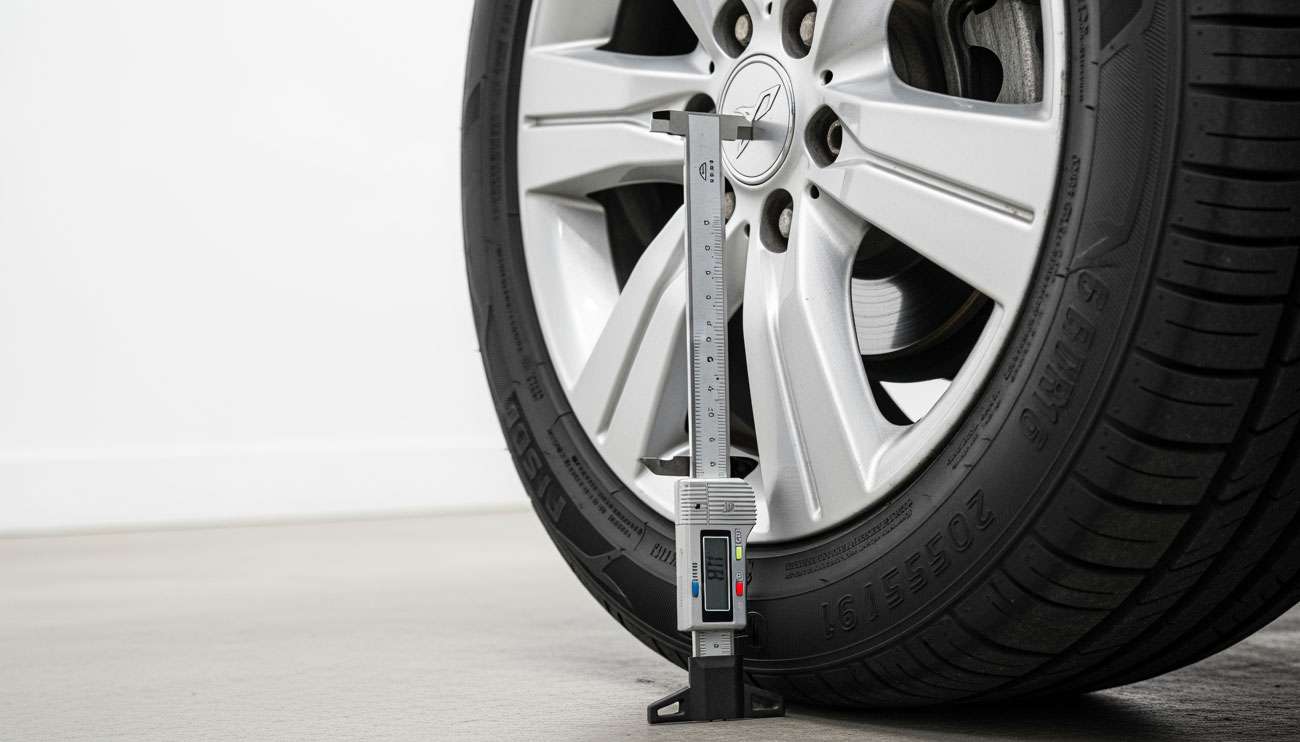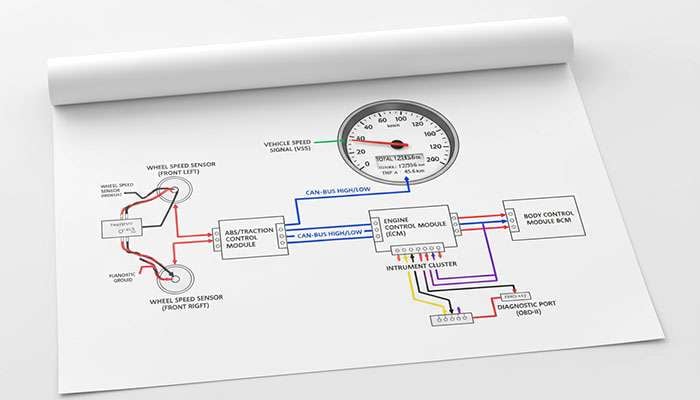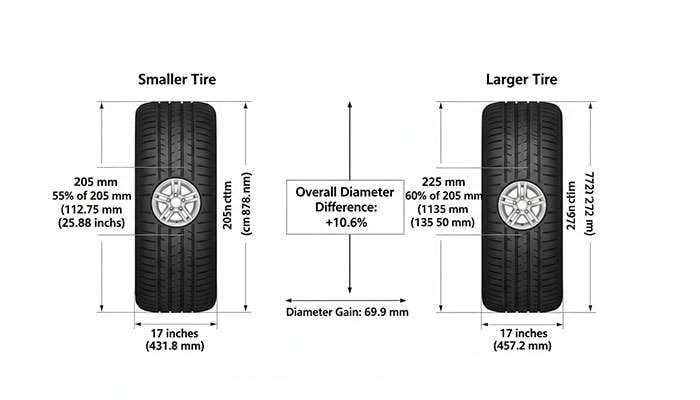
Switching from a 205/55R16 tire to a 205/40R16 creates a 10.8% difference in diameter. Understanding what size tire is a 205 55R16 is essential for proper vehicle performance and safety.
The 205/55R16 measures approximately 25 inches in diameter, with a circumference of 78.16 inches (1985.17 mm). This specific size completes about 810.68 revolutions per mile. These measurements directly impact how your vehicle performs on the road.
Tire size changes make a significant difference in your driving experience. Moving to a 205/60R16 increases diameter by 3.1%, while dropping to a 205/40R16 reduces it by 10.8%. These variations affect speedometer readings, fuel economy, and overall vehicle handling.
We'll decode exactly what each number in the 205/55R16 designation means, provide complete dimensional breakdowns in both metric and imperial measurements, and show you how this size compares to alternative options for your vehicle.

The tire code 205/55R16 provides essential specifications about tire dimensions and construction. Each number and letter serves a specific purpose in defining how this tire will perform on your vehicle.
The first number, 205, indicates the tire's section width measured in millimeters from sidewall to sidewall at the widest point. This measurement represents the tire's footprint width when properly mounted and inflated. Converting to inches requires dividing by 25.4 millimeters per inch, giving us approximately 8.07 inches. Section width directly influences traction characteristics and handling response.
The aspect ratio of 55 represents the sidewall height as a percentage of the section width. With our 205mm width, the sidewall measures 55% of that distance. The calculation is straightforward: 205 mm × 0.55 = 112.75 mm (4.44 inches). This sidewall height affects ride quality, handling precision, and impact resistance.
"R" designates radial construction, the standard tire design used across modern vehicles. The "16" specifies the rim diameter in inches, meaning this tire requires a 16-inch wheel measured at the bead seat area. The 205/55R16 accepts rim widths from 5.5 to 7.5 inches, with optimal performance on 6.0, 6.5, or 7.0-inch wide rims.
Complete dimensional specifications in inches:
Section Width: 8.07 inches
Sidewall Height: 4.44 inches
Rim Diameter: 16.00 inches
Overall Diameter: 24.88 inches
Circumference: 78.16 inches
Radius: 12.44 inches
The overall diameter combines the rim diameter plus two sidewall heights: (2 × 4.44) + 16 = 24.88 inches. This measurement determines vehicle clearance requirements and compatibility with suspension components.
This tire size ranks among the most popular passenger car applications, ensuring wide availability across tire brands and performance categories.
Precise tire dimensions determine how your vehicle handles, rides, and performs on the road. The 205/55R16 size delivers specific characteristics that affect your daily driving experience.
The 205/55R16 tire measures 24.88 inches in overall diameter, which equals approximately 631.9 mm. This total combines the 16-inch rim diameter with twice the sidewall height (4.44 inches × 2). This diameter places the tire in the medium-size category, providing a balanced approach between ride comfort and responsive handling.
Section width spans 8.07 inches (205 mm), while sidewall height reaches 4.44 inches (112.75 mm). The sidewall calculation is straightforward: 55% of the section width (205 mm × 0.55 = 112.75 mm). The radius measures exactly half the overall diameter at 12.44 inches.
Circumference measures 78.16 inches (1985.17 mm) for the 205/55R16 size. This figure determines the distance your tire covers with each complete rotation. The calculation multiplies diameter by pi (24.88 × 3.14 = 78.16 inches).
A 205/55R16 tire completes between 810.68 and 836.08 revolutions per mile. Manufacturing variations between tire models account for this range in specifications. At highway speeds, your tire rotates approximately 836 times per mile.
The low profile classification for 205/55R16 tires depends on current industry standards and regional preferences. Traditionally, tires with aspect ratios of 55 or lower earned the low profile designation. Based on this standard, a 205/55R16 would qualify.
Modern automotive trends have shifted this classification significantly. European markets now consider 205/55R16 one of the most popular sizes for mid-range vehicles, often removing it from the low profile category. Today's true low profile designation typically applies to aspect ratios of 40% or less.
The 205/55R16 strikes a practical balance compared to ultra-low-profile options with aspect ratios below 45%. The 55 aspect ratio delivers adequate sidewall cushioning while maintaining responsive handling feedback for most driving conditions.

Tire size changes affect more than just appearance. When you switch tire sizes, your vehicle's electronic systems need to compensate for the difference in rotations per mile. These changes impact speedometer readings, final drive ratios, and overall performance characteristics.
Your speedometer calibration depends on tire circumference. A 205/55R16 tire completes 836 revolutions per mile. Switching to a 205/40R16 reduces circumference enough that your speedometer reads 64.8 mph when you're actually traveling 60 mph. A larger 205/60R16 size creates the opposite effect - your speedometer shows 58.1 mph at actual 60 mph speeds.
Your engine RPM depends on tire size and final drive ratio. At 65 mph with 205/55R16 tires, expect 2,399 RPM with a 2.73 gear ratio, 3,005 RPM with a 3.42 ratio, and 4,507 RPM with a 5.13 ratio. These numbers show the relationship between gear ratios and engine efficiency.
This tire size provides solid fuel efficiency for everyday driving. Tire size changes have minimal impact on fuel consumption, though smaller diameter tires rotate faster at highway speeds, potentially using slightly more fuel. Real-world testing shows that switching from 215/55R16 to 205/55R16 can actually improve fuel economy thanks to reduced weight and lower rolling resistance.

When shopping for replacement tires, knowing which alternatives work with your vehicle is essential for maintaining proper performance. Here are the compatible options for the 205/55R16 size and how they stack up.
The key rule for safe tire substitution is staying within 3% of your original tire's diameter. Several sizes meet this requirement:
195/55R16 (-1.74% diameter difference)
215/50R16 (-1.66% difference)
185/60R16 (-0.55% difference)
225/50R16 (-0.08% difference)
195/60R16 (+1.35% difference)
The 225/50R16 provides the closest match, with virtually identical overall diameter.
The 205/60R16 keeps the same width but adds sidewall height. With these tires installed, your speedometer reads 58.11 mph when you're actually traveling 60 mph, creating about a 3.1% difference. This change affects ride quality and engine performance - at 65 mph with a 3.42 gear ratio, your RPMs drop from 3002 to approximately 2906.
Switching to a 215/50R17 brings these changes:
Width increases by 10mm (+5%)
Overall diameter increases by 15mm (+2%)
Circumference grows by 47mm (+2%)
Sidewall height decreases by 5mm (-5%)
This combination provides a wider contact patch while maintaining nearly the same overall height.
You'll find 205/55R16 tires on popular compact and mid-size vehicles including the Toyota Corolla, Honda Civic, Nissan Altima, and Ford Fusion. This size works well for passenger vehicles across all-season, all-weather, winter, and performance applications.
Ready to find quality 205/55R16 tires at competitive prices? Check out Performance Plus Tire's selection for a wide range of options designed to meet your specific driving needs.
Tire specifications make all the difference when selecting the right tires for your vehicle. We've broken down what a 205/55R16 tire means - from its 205mm width and 55% aspect ratio to its 16-inch rim diameter. This knowledge helps you make informed decisions for optimal vehicle performance.
The key measurements we've covered directly impact speedometer accuracy, fuel consumption, and handling characteristics. These specifications determine which alternative sizes work for your vehicle while staying within the safe 3% diameter variation range.
Tire size changes affect more than just appearance. Moving from the standard 205/55R16 to alternatives like 225/50R16 or 195/60R16 changes vehicle clearance, handling response, and fuel efficiency.
For quality 205/55R16 tires, Performance Plus Tire offers an excellent selection with options for various driving conditions and preferences. This size works well across numerous vehicle models because it provides balanced performance characteristics.
We recommend checking your vehicle manufacturer's specifications before making any tire size changes. The right tire choice balances performance, comfort, and safety while meeting your specific driving requirements. Those numbers on your sidewall contain the complete story of how your vehicle connects with the road.
Understanding tire codes helps you make informed decisions about replacements and ensures optimal vehicle performance and safety.
• 205/55R16 breakdown: 205mm width (8.07"), 55% aspect ratio (4.44" sidewall), radial construction, 16" rim diameter • Overall dimensions: 24.88" diameter, 78.16" circumference, completing approximately 811 revolutions per mile • Safe substitutes: Stay within 3% diameter difference; 225/50R16 (-0.08%) and 195/60R16 (+1.35%) are ideal alternatives • Performance impact: Tire size changes affect speedometer accuracy, RPM, and fuel economy significantly • Popular fitment: Common on Toyota Corolla, Honda Civic, Nissan Altima, and Ford Fusion models
When selecting replacement tires, always consult your vehicle manufacturer's specifications to ensure proper fitment and maintain optimal performance characteristics.
The 205/55R16 tire size breaks down as follows: 205 mm is the width, 55 is the aspect ratio (sidewall height as a percentage of width), R indicates radial construction, and 16 is the rim diameter in inches.
The main difference is in the sidewall height. The 205/60R16 has a taller sidewall (60% of width vs 55%), resulting in a slightly larger overall diameter and potentially a softer ride compared to the 205/55R16.
Yes, but it's crucial to stay within 3% of the original tire's diameter. Good alternatives include 225/50R16 or 195/60R16, which have minimal impact on vehicle performance and speedometer accuracy.
Tire size can influence fuel economy, though usually minimally. Smaller diameter tires may slightly increase fuel consumption due to higher RPMs, while larger tires might improve efficiency. However, factors like weight and rolling resistance also play significant roles.
205/55R16 tires are commonly found on compact and mid-size vehicles such as the Toyota Corolla, Honda Civic, Nissan Altima, and Ford Fusion. They're popular for their balanced performance in various driving conditions.